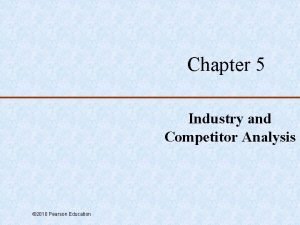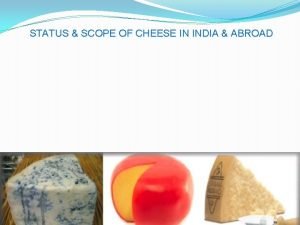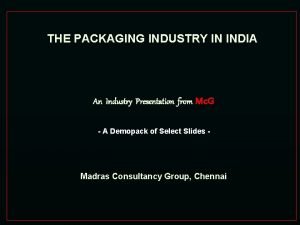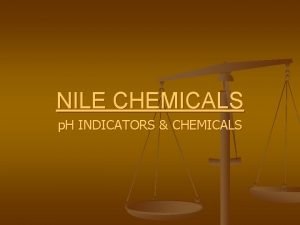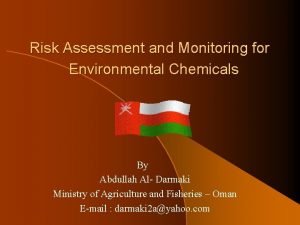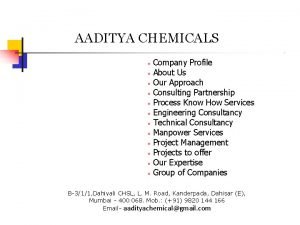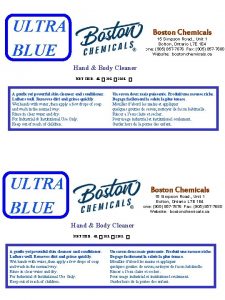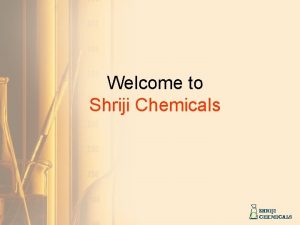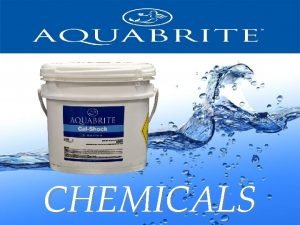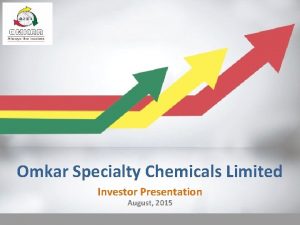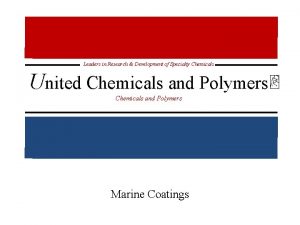Specialty Chemicals Opportunities ahead in India Industry Overview















- Slides: 15

Specialty Chemicals – Opportunities ahead in India

Industry Overview • • • Global Specialty Chemicals market accounted for $1. 11 trillion in 2017 and is expected to reach $1. 97 trillion by the year 2026 Specialty chemicals market is expected to register a CAGR of 6. 5% during the forecast period of 2017 - 2026 Asia-Pacific is estimated to lead the market owing to its rapid economic and industrial growth, especially in the paints and coating industry segment The Indian chemicals sector is a market worth about USD 160 billion, with specialty chemicals representing about 20 per cent of the value The domestic specialty chemical sector is expected to grow by about 10 per cent annually to almost double the market size by FY 25

Industry Overview…. Contnd • From a distant 3 rd player, China has become a leader over the last decade • China has come up with a ‘Blue Sky’ policy focused on introducing stringent pollution control norms to improve air quality. Last year China shut down around 25 chemical plants along the river Yangtze within a month Though China is still a dominant player but increasing focus on environmental concerns is impacting the growth and this is where India has a golden opportunity to grab a larger pie of the Industry Major global companies in this space are BASF, Dow Chemical, Dupont, Clariant • •

Chemical Sector Value Chain Raw Materials n Raw materials are mainly metallic or non- metallic minerals , oils and natural gas extracted from mining Basic Chemicals n Basic chemicals production from raw materials is second step in the value chain n Involves raw material procurement, R&D, develo pment and patenting of innovative chemicals and chemical processes n These basic chemicals are used as raw materials to manufacture commercial products such as dyes, detergents, chemical n Refining of oil and gas into Petrochemicals n Includes synthesis, distillation, thermal cracking and polymerization n Products manufactured during this step includes Olefins (ethylene & Propylene), Polyolefins and industrial gases n Products manufactured during this step includes Intermediates Polymers n This step involves the manufacturing of polymers from basic chemicals n Polymer manufacturing is hybrid of batch and continuous processing n Raw materials for polymers referred to as feedstocks are by-products of petroleum or natural gas production generally produced in step 2 n Polymers, principally used to make plastic goods constitute about 80% of the chemical industry’s production output Specialty Chemicals n Most complex chemicals produced during fourth step known as specialties chemicals n Fine chemicals are complex, pure chemical substances produced by traditional organic synthesis in multipurpose plants n These fine chemicals are used as starting materials for specialty chemicals n SC are used for a variety of purposes and include additives, coatings, pharmace uticals and vitamins

Sector Understanding • The chemical industry is classified on the basis of value add and the major categories are as follows • • SC is a capital intensive industry with complex technological products and processes It’s categorized as a cyclical sector since the major raw material consumed to produce specialty chemicals are natural gas and petroleum products and hence the volatility in oil and gas prices impacts it’s profitability

Sector Understanding – Contnd. . • • Specialized nature of products leads to significant differentiation Factors such as substantial research and development (R&D) requirements, technical skills, capital intensiveness, long approval process and stringent regulations create important barriers to entry SC is a consumer driven sector and the companies in this sector compete based upon pricing, technology and services. Vendors operating in the Specialty Chemicals Market strive to deliver the best quality products based on innovative technologies and best practices Raw materials account for ~> 60% sales for most chemical companies. Any increase in raw material prices significantly impacts the profitability but one big advantage is that the established players have pricing power and can pass on the added cost to the customer

Growth Drivers for Indian SC • • • Domestic availability of raw materials at competitive prices With increased GDP and consumption led double digit growth in key markets, there is a big domestic market already in place Strong demand growth in consumer industries and a domestic industry supports ‘premiumisation’ of products Growing trend of easternization and reduction of capacities in China on environmental concerns. Low cost manufacturing Policy support from Government - set up a National Chemical Policy to accelerate the manufacturing in the chemical sector Strong Engineering and R&D Capabilities Strong base of technically skilled manpower with the expertise needed to store and handle chemicals Supporting FDI policy with 100% FDI investment allowed in this sector Most of the chemicals currently are under 18% GST slab in India and going forward the Govt is aiming to bring almost all the items under 12% slab that can be another positive for the sector

Key Risks To The Sector • • Regulatory overhang since pollution is a key concern so there is always a threat of ban of products by the Government Change in environment regulations and delay in environmental clearances Fluctuation in raw material prices Delay in product approval from Customer and as well as regulators China may decide to loosen it’s pollution norms again since their economy is going through a rough phase Currency volatility risk as the companies in this sector have a large part of their revenue coming from exports in multiple countries Demand Supply imbalance : e. g. Phenol and Acetone price dropped by 27% in last 3 months in China thereby denting the margins of Deepak Nitrite significantly Dependency on major suppliers

Key Sub-Segments & Market Share

Key Players COLORANTS AARTI INDUSTRIES v. Top tier specialty chemical player in Benzene derivatives segment v. Diversified product offerings with 200+ products and 1000+ customers in more than 41 countries v Recently won two major long term contracts of value with revenue visibility of Rs 9 bn per year v. Follows a Cost plus pricing model and hence is immune to raw material volatility to some extent v. Foraying into new derivatives such as Toluene v. One of the largest integrated dye-stuff manufacturer with 25% and 13% domestic market share in dye intermediates & dye stuff respectively v. Almost debt free company with a major capex completed recently more than doubling the capacity of dye stuff in March ‘ 2018 BODAL CHEMICALS v. Presence across entire dye stuff value chain reducing dependency on supplier and cost advantage v. Export revenue 45% with sales to 150+ Customers in 45+ Countries v. Debt free company with consistent track record of expansion in growth areas

Key Players COLORANTS/FRAGRANCES Atul Ltd SH KELKAR v. One of the largest integrated chemicals company with a diversified product portfolio of 1350+ across multiple business segments v. Operates primarily through 6 business divisions namely Colorants, Pharmaceuticals, Agrochemical, Intermediates and Polymers v. Undergone major capex of 360 cr over last 3 years with focus on significantly expanding it’s base in specialty bulk chemical and specialty polymers v. Debt free company with strong management (Lalbhai group) v. Management targeting 15%+ revenue CAGR in coming years with improving profitability due to sustained effort to launch higher margin products v. One of India’s largest fragrance and flavor company with market share of 14%+ v. Strong relationships with fast-growing FMCG companies, high exposure to emerging geographies & product innovation are the key for the company’s growth v. Emerging player in India’s INR 18. 8 bn flavor market which is dominated by small unorganized players providing huge opportunity for players like SHKL to grow v. Strategy shift in ingredients and exports business to drive margins – intends to shift production to low cost Vapi facility and outsource production of low value items.

Key Players OTHERS (RUBBER /CARBON BLACK) NOCIL PHILIP CARBON BLACK v. India’s largest manufacturer and supplier of rubber chemicals v. Acknowledged as a dependable supplier of rubber chemicals due to it’s decades of experience and one stop shop offering to customers v Debt free company with last 3 year average ROE and ROCE of 18% v. Undergoing a significant capex of 425 cr mainly to be funded by internal accruals and will double the asset turnover v. It’s a part of Arvind Mafatlal group and has a sound management v 7 th largest Carbon black company globally with leadership position in Carbon black in India v. Low financial leverage with penetration in new geographies and increasing Customer base v. Currently in the midst of a brownfield expansion of 320 cr to increase its specialty black capacity by 32000 MT and Rubber carbon black by 48, 000 MT v. Developing new specialty applications to cater to automotive, consumer electronics and home appliances market

Evaluation Parameters Management Financial Scalability Valuation Risk AARTI Industries Atul Industries Bodal Chemicals NOCIL SH KELKAR Philip Carbon Black strong weak

API Opportunity • • Total production market of API in India was valued at approximately US$ 11 Billion in FY 2016. This market is forecasted to grow at a CAGR of around 9% during the period of FY 2016–FY 2022 Of the total domestic consumption, ~ 32% is imported. Of the total imports, China alone accounts for 57 -60% of the APIs imported by India Ongoing supply disruptions in China on account of an estimated 40 percent of all China factories being shut down in the last one year itself presents huge growth opportunity for API producers in India China has started increased API prices as labour costs had gone up in that country. This is the right opportunity for India to develop APIs and intermediates. China has started purchasing APIs from India and concentrating on manufacture of formulation drugs

Divi’s Labs attractive API bet Robust financials with ROCE 21% + and ROE 15%+ • Promoter holding above 50% and debt free company • Healthy Operating margin of 40% • Management is quite bullish on APIs and sees a multi-year opportunity in the sector • Embarked on a Rs 1200 crore fresh brownfield capital expansion at its two units in Visakhapatnam and Hyderabad. Some of the other major players in this space are § Laurus labs § Aurobindo pharma § Hikal § Lupin • Stock generated > 50% return since Jan’ 18
 Commodity vs specialty chemicals
Commodity vs specialty chemicals Behn meyer specialty chemicals llp
Behn meyer specialty chemicals llp Industry analysis of apple
Industry analysis of apple Consulting industry overview
Consulting industry overview Telecom industry overview
Telecom industry overview Competitor grid
Competitor grid Site:slidetodoc.com
Site:slidetodoc.com Distribution of cotton woollen and silk industries
Distribution of cotton woollen and silk industries Hvac industry in india
Hvac industry in india Packaging trends in india
Packaging trends in india Nile chemicals
Nile chemicals Oman chemicals
Oman chemicals Kinetics flotation chemicals
Kinetics flotation chemicals Aaditya chemicals
Aaditya chemicals Boston chemicals
Boston chemicals Shriji chemicals
Shriji chemicals





